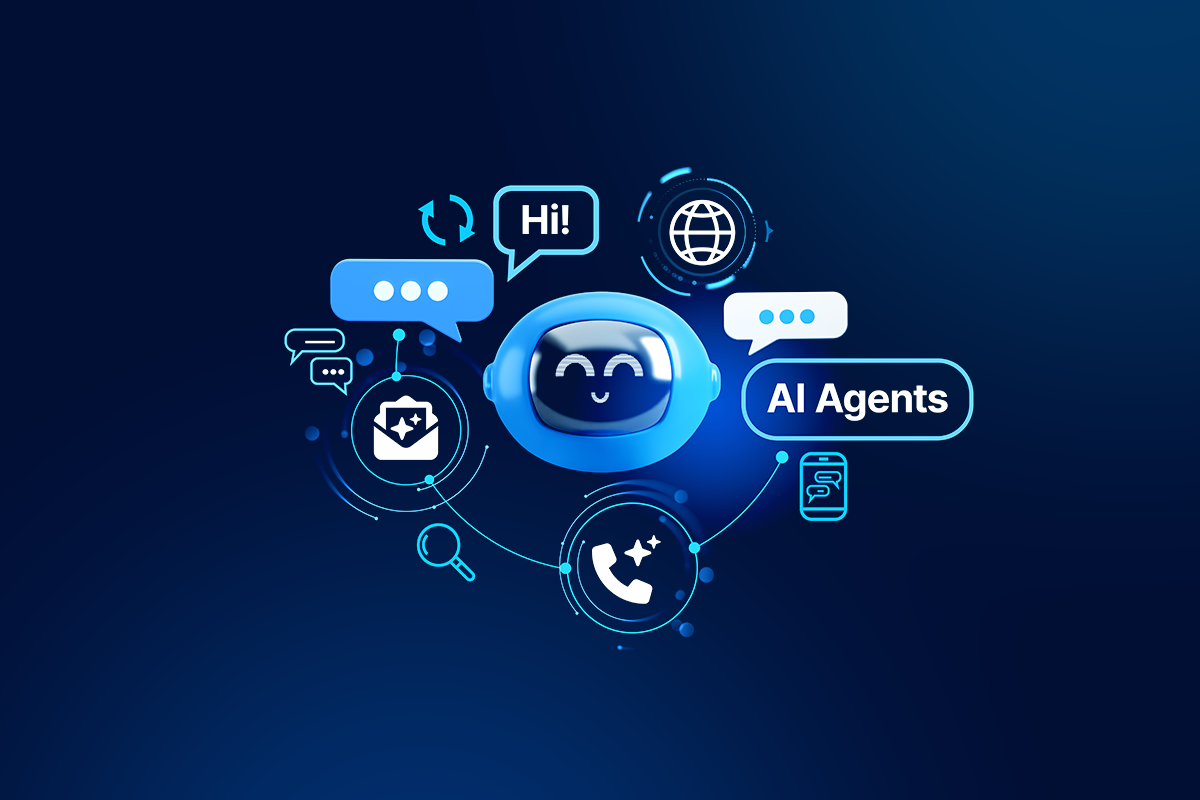The integration of AI into enterprise operations is no longer a futuristic concept—it’s the present. From customer service to supply chain management, enterprises are adopting AI at an unprecedented rate, transforming workflows and outcomes. The global AI chatbot market is expected to be worth $455 million by the end of 2027, underscoring its growing importance. But while conventional AI chatbots have proven beneficial, they are no longer enough in an era demanding higher adaptability, smarter decision-making, and process integration.
Enter agentic AI, the next leap in enterprise technology. Evolving beyond chatbots, agentic AI agents offer enterprises proactive and autonomous solutions designed to optimize operations across departments.
This blog will explore the limitations of traditional enterprise AI chatbot solutions, introduce agentic AI as a transformational catalyst, and highlight how enterprise leaders can leverage it for sustained competitive advantage.
What is an enterprise AI chatbot solution?
Enterprise AI chatbot solutions are software platforms driven by artificial intelligence, natural language processing (NLP), and machine learning (ML) to automate customer interactions and internal processes. With natural language understanding (NLU), these chatbots can interpret customer intent, offer personalized responses, and escalate complex issues to human agents.
Legacy conversational AI in enterprise AI chatbot solutions
Conversational AI in enterprise solutions represents technology that enables natural, human-like interactions between businesses and their customers through intelligent chatbots and virtual assistants. These systems combine the technologies described above—Natural Language Processing (NLP), Machine Learning, and Deep Learning—to understand, process, and respond to human language in context.
But as we will see, agentic AI takes over from conversational AI to handle complex dialogues, remember conversation history, understand user intent, and provide personalized responses across multiple channels and languages in a way that prior-gen AI could not. These solutions can integrate with existing business systems (like CRM, ERP, and knowledge bases) to automate customer service, sales support, and internal operations, while continuously learning from interactions to improve accuracy and effectiveness.
Core features of enterprise AI chatbot solutions
1. Handling high volumes of requests
Enterprise chatbots aim to manage thousands of simultaneous interactions, offering round-the-clock availability without human intervention.
2. Escalation to human agents
When complex issues arise, chatbots transfer customers to live agents without losing conversation context for continuity and smooth interactions.
3. Integration with other enterprise tools
Integrating AI chatbots with existing tech stacks improves efficiency and customer experience. By connecting with tools like CRMs, ERPs, HR systems, and helpdesk software, chatbots access data to deliver personalized, accurate responses. For instance, they can check inventory, update orders, or enable targeted upselling, streamlining operations and enhancing service quality for customers and employees.
4. Support for internal processes
Beyond customer service, chatbots help employees with onboarding, training, and data collection, making them indispensable for growing enterprises.
Benefits of enterprise AI chatbot solutions
Cost savings
Automating repetitive tasks reduces reliance on human agents, leading to savings in labor costs.
Enhanced operations
Chatbots streamline workflows, reduce wait times, and improve customer satisfaction scores.
Scalable and consistent service
Whether answering FAQs or managing complex queries, these bots offer consistent service quality at scale.
However, despite their utility, traditional enterprise AI chatbots remain reactive—responding to instructions, but unable to anticipate problems or dynamics. This is where agentic AI paves the way forward.
From chatbots to agentic AI for enterprises
Agentic AI represents an evolution in enterprise artificial intelligence. While chatbots are reactive tools limited to predefined interactions, agentic AI agents are capable of proactive decision-making and autonomous action. With capabilities rooted in real-time adaptation, agentic AI has redefined AI’s role in the enterprise landscape.
Chatbots vs. agentic AI agents
Reactive vs. proactive
Chatbots react to user queries; agentic AI anticipates needs before they are expressed. For example, instead of merely answering a customer’s inquiry about delayed shipments, agentic AI could autonomously identify delays, notify affected customers, and initiate remediation.
Static decision-making vs. dynamic learning
Where chatbots rely on static rules, agentic AI improves continuously by learning from interactions, refining its predictive capabilities.
Siloed functionality vs. cross-departmental efficiency
Traditional chatbots typically serve a single function (e.g., customer service). Agentic AI spans departments, breaking silos by automating workflows in HR, supply chains, marketing, and more.
Cost vs. ROI
Agentic AI is already providing faster time-to-value than last-gen enterprise AI chatbot solutions. While implementing agentic AI requires an initial investment in technology and training, the returns justify the expenditure. Organizations typically see ROI through reduced operational costs, increased efficiency in process completion, higher customer satisfaction scores, and improved employee productivity.
When evaluating costs, consider not just platform pricing, but also integration expenses, training requirements, and maintenance—then weigh these against projected gains in automation, reduced error rates, faster resolution times, and the ability to scale operations without proportional increases in headcount.
Practical applications of agentic AI in enterprises
1. Customer service
Agentic AI can revolutionize customer service by going beyond simply answering customer queries. Imagine an AI that not only resolves issues efficiently, but also analyzes customer sentiment, behavior, and usage patterns to predict potential churn well in advance.
By identifying dissatisfied customers, it can automatically trigger personalized retention efforts, such as offering discounts, tailored recommendations, or proactive solutions, ensuring a more seamless and satisfying customer experience while boosting loyalty.
2. Human resources
Agentic AI can significantly streamline and enhance human resources operations. For example, it can handle the initial stages of hiring by screening resumes and applications for relevant skills and experience, thereby reducing the workload of HR teams.
It can also manage interview scheduling, ensuring candidates and hiring managers are aligned with minimal manual intervention. Once employees are onboarded, agentic AI can be used to monitor engagement and morale through sentiment analysis of internal communications or surveys, helping HR teams identify potential issues, such as burnout or dissatisfaction, before they escalate. This proactive approach fosters a healthier and more motivated workforce.
3. Supply chain management
In the realm of supply chain management, agentic AI can help businesses maintain agility and cost-efficiency. By analyzing historical data, market trends, and real-time inputs, it can accurately anticipate demand surges and adjust inventory levels dynamically to prevent shortages or overstocking. This is particularly valuable during peak seasons or unforeseen disruptions.
Moreover, agentic AI can optimize logistics by suggesting the most efficient routes and delivery schedules, reducing costs and improving supply chain performance. By automating these complex processes, businesses can react faster to changes in demand and ensure smoother operations.
These examples illustrate why enterprises can no longer rely solely on static chatbot solutions. Agentic AI offers dynamic, intelligent, and proactive capabilities that go beyond traditional automation, driving better outcomes across various business functions. Investing in these advanced AI solutions is becoming essential for staying competitive.
9 key features that set agentic AI apart in enterprise applications
To fully grasp agentic AI’s potential, it’s essential to understand the distinct features that differentiate it from its chatbot predecessors.
1. Contextual understanding
Agentic AI excels at maintaining context across multi-turn conversations, enabling more natural, human-like interactions compared to general chatbots, which often reset or lose track of context.
2. Proactive adaptability
Agentic AI evolves dynamically by analyzing patterns, allowing it to predict user needs and act without user prompting. For example, an agentic AI might automatically notify customers of service disruptions and provide alternatives.
3. Enhanced decision-making
Agentic AI provides real-time data-driven insights, enabling businesses to act swiftly and effectively. By analyzing patterns, it identifies opportunities and offers strategic recommendations.
4. Scalability without compromise
Despite handling vast interactions, agentic AI maintains the precision and personalization that differentiate high-quality customer experiences from generic ones.
5. Dynamic integrations
With the ability to integrate into multiple systems—be it CRMs or ERPs—agentic AI streamlines sophisticated workflows and data sharing, and facilitates cross-departmental communication effortlessly.
6. Multilingual capabilities
Designed for global enterprises, agentic AI can carry out region-specific conversations in multiple languages, ensuring effective communication across borders.
7. Security and compliance
Given the growing scrutiny of AI technologies, agentic AI comes with built-in safeguards to ensure user data is protected and compliance thresholds are met.
8. Human handoff recognition
Unlike basic chatbots that can create frustrating experiences when escalating to human agents, agentic AI possesses sophisticated recognition capabilities to identify when human intervention is necessary.
The system can intelligently determine the complexity and emotional nuance of interactions, seamlessly transferring conversations to human agents at the optimal moment, while providing them with full context and relevant customer data to ensure a smooth transition.
9. Learning and adaptation
Agentic AI continuously learns and adapts from interactions, improving over time and delivering increasingly accurate and efficient responses.
How to get started with agentic AI
Transitioning from conventional chatbot solutions to agentic AI may seem daunting, but it can be achieved with a structured approach.
Step 1: Conduct a needs assessment
Evaluate your enterprise’s current processes and identify areas where greater autonomy and efficiency are required.
Step 2: Choose the right agentic AI solution
You’ll need to decide whether to build or buy your AI, or buy-to-build. Prioritize solutions like Quiq’s AI Studio, which focus on AI practices like scalability, integration, and observability.
Step 3: Plan for phased implementation
Adopt a phased strategy to minimize operational disruptions during the transition from traditional tools to agentic AI systems.
Step 4: Train your teams
Equip employees with the resources and skills needed to leverage agentic AI effectively within their workflows.
Step 5: Monitor and optimize
Continuously analyze the impact of agentic AI on KPIs like cost savings, customer satisfaction, and employee productivity. Use this data to refine operations.
Agentic AI is the strategic advantage of tomorrow
The transition from basic enterprise AI chatbot solutions to the cutting-edge potential of agentic AI has begun. Enterprises that adopt this new technology will unlock operational efficiencies, improve customer experiences, and gain competitive advantages that were once unimaginable.
Agentic AI is not just a tool—it’s a strategy for building future-ready enterprises prepared for the demands of a dynamic business ecosystem.




